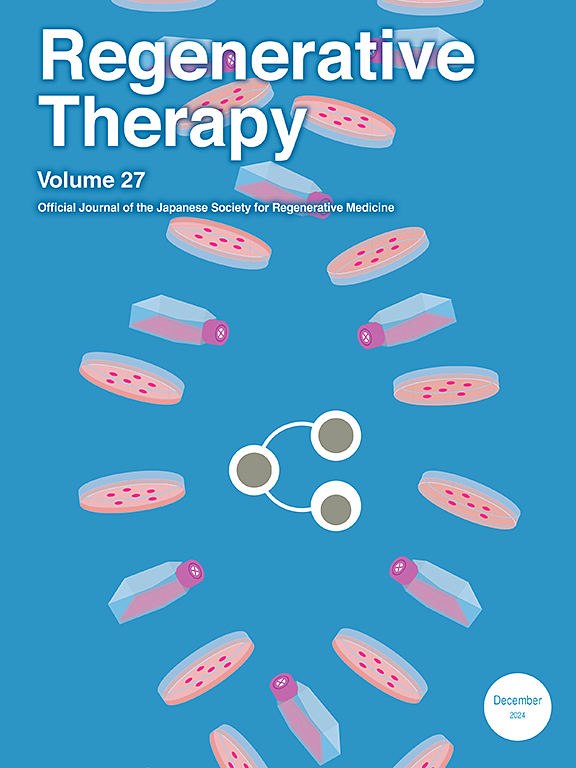经监管机构批准后,日本眼科再生医疗产品的官方国民保险覆盖范围评估
IF 3.5
3区 环境科学与生态学
Q3 CELL & TISSUE ENGINEERING
引用次数: 0
摘要
近年来,日本再生医学领域在眼科疾病的治疗方面取得了重大进展,重点放在临床研究和实际应用上,2014年,一项重大进展是启动了世界上第一个使用iPS细胞治疗年龄相关性黄斑变性的临床研究。此外,最近日本厚生劳动省(MHLW)和日本药品和医疗器械管理局(PMDA)根据《药品、医疗器械和其他治疗产品法》(PMD法)批准了三种用于治疗角膜缘干细胞缺乏症的再生医疗产品。角膜缘干细胞缺乏症是一种罕见且难治性的眼表疾病。为了加快再生医学的实际实施,《PMD法》在现有的两个类别(即“医药产品”和“医疗设备”)之外,为再生医疗产品提出了一个新的类别。然而,在目前的日本官方国民保险覆盖计划中,没有指定“再生医疗产品”的类别。虽然再生医疗产品的审批制度因国家而异(即美国食品和药物管理局(U.S. FDA),欧洲药品管理局(EMA)等),但在日本,它们是由日本MHLW和PMDA批准的。当制造商在日本寻求将新批准的再生医疗产品纳入日本国民保险计划所列产品时,这些产品被归类为“医药产品”或“医疗器械”,并由日本卫生和社会福利部的中央社会保险医疗委员会("Chuikyo")进行审查。虽然申请监管批准和保险范围的责任在于制造商,但作为对两种眼科再生医疗产品(即Sakracy®和Vyznova®)进行临床研究和研究者发起的临床试验的开发者,我们认为这两种产品从监管批准到保险范围上市的时间比其他眼科再生医疗产品要长。这些经验成为研究问题,重点是眼科再生医疗产品,这一提交的理由是,传播我们的经验将有利于所有临床研究人员和制造商。因此,本研究旨在探讨日本眼科再生医疗产品的保险覆盖情况,并从具体的保险相关类别入手。方法本研究以日本2014年修订的药事法生效后新批准的眼科再生医疗产品为研究对象。每种产品的保险范围类别(即“医药产品”或“医疗器械”)以及从监管部门批准到保险范围上市的期间根据日本MHLW的公开材料进行了审查。结果截至2024年底,五种产品被纳入保险范围。Luxturna Injection®(Novartis Pharma)归类为药品的期限为65天,在药品的标准管理处理时间内(即60天或更短,但不迟于90天),而归类为医疗器械的Nepic®和Ocural®(日本组织工程)、Sakracy®(CynosBio)和Vyznova®(日本Aurion Biotech)的经过时间分别为74天、173天、224天和534天。Sakracy®和Vyznova®的期限超过了医疗器械的标准管理处理时间,原则上范围为5至6个月。此外,Vyznova®从监管部门批准到保险范围上市的时间是Sakracy®的两倍多。归类为医疗器械的再生医疗产品需要经过日本中央社会保险医疗委员会医疗器械保险材料技术委员会的审查过程。我们的研究结果表明,制造商和监管当局都需要从日本将再生医疗产品投入实际临床使用的角度修改技术委员会的战略。本文章由计算机程序翻译,如有差异,请以英文原文为准。
Assessment of the official national insurance coverage of regenerative medical products for ophthalmic diseases in Japan following regulatory approval
Introduction
Recently, significant progress has been made in the field of regenerative medicine in Japan for the treatment of ophthalmic diseases, with a notable emphasis placed on clinical research and practical applications, and in 2014, one significant development was the initiation of the world's first clinical research using iPS cells for age-related macular degeneration. In addition, three regenerative medical products for the treatment of limbal stem cell deficiency, a rare and intractable ocular surface disease, have recently been approved by the Japanese Ministry of Health, Labour and Welfare (MHLW) and the Japanese Pharmaceuticals and Medical Devices Agency (PMDA) under the Pharmaceuticals, Medical Devices, and Other Therapeutic Products Act (PMD Act). In order to expedite the practical implementation of regenerative medicine, the PMD Act presented a new category for regenerative medical products alongside the two categories that currently exist (i.e., 'pharmaceutical products' and 'medical devices'). However, within the current official Japanese national insurance coverage plan, there is no category designated for 'regenerative medical products'. Although the approval system for regenerative medical products differs from country to country (i.e., the United States Food and Drug Administration (U.S. FDA), the European Medicines Agency (EMA), etc.), in Japan, they are approved by the Japanese MHLW and PMDA. When manufacturers seek newly approved regenerative medical products in Japan to be incorporated within those listed in the Japanese national insurance coverage plan, the products are classified as either 'pharmaceutical products' or 'medical devices' and are reviewed by the Central Social Insurance Medical Council ("Chuikyo", in Japanese) of the Japanese MHLW. Although the responsibility for applying for regulatory approval and insurance coverage lies with the manufacturer, as the developer who conducted the clinical study and the investigator-initiated clinical trial for two ophthalmic regenerative medical products (i.e., Sakracy® and Vyznova®), we perceived that the period from regulatory approval to insurance coverage listing for these two products was longer than for other ophthalmic regenerative medical products. These experiences became the research question and the focus was on ophthalmic regenerative medical products, with the rationale behind this submission being that the dissemination of our experience will be of benefit to all clinical researchers and manufacturers. Hence, the purpose of this present study was to investigate the insurance coverage of regenerative medical products for ophthalmic diseases in Japan from the aspect of specific coverage-related categories.
Methods
In this study, we investigated newly approved regenerative medical products for ophthalmic diseases in Japan after the Revised Pharmaceutical Affairs Act came into effect in 2014. The insurance coverage categories (i.e., 'pharmaceutical products' or 'medical devices') of each product and the period from regulatory approval to insurance coverage listing were examined based on publicly available materials from the Japanese MHLW.
Results
As of the end of 2024, five products are included on the insurance coverage list. The period for Luxturna Injection® (Novartis Pharma), categorized as a pharmaceutical product, to be included was 65 days, which was within the standard administrative processing time for pharmaceutical products, (i.e., 60 days or less, yet no later than 90 days), while the elapsed periods for Nepic® and Ocural® (Japan Tissue Engineering), Sakracy® (CynosBio), and Vyznova® (Aurion Biotech Japan), which are categorized as medical devices, were 74, 173, 224, and 534 days, respectively. The periods for Sakracy® and Vyznova® exceeded the standard administrative processing time for medical devices, which in principle ranges from 5 to 6 months. Moreover, the elapsed period of time from regulatory approval to insurance coverage listing for Vyznova® was more than twice as long as that which occurred for Sakracy®.
Conclusions
Regenerative medical products categorized as medical devices are required to undergo a review process conducted by the Technical Committee for Insurance Materials on Medical Devices of the Japanese Central Social Insurance Medical Council. Our findings suggest that both manufacturers and regulatory authorities need to revise the Technical Committee's strategy from the aspect of putting regenerative medical products into practical clinical use in Japan.
求助全文
通过发布文献求助,成功后即可免费获取论文全文。
去求助
来源期刊

Regenerative Therapy
Engineering-Biomedical Engineering
CiteScore
6.00
自引率
2.30%
发文量
106
审稿时长
49 days
期刊介绍:
Regenerative Therapy is the official peer-reviewed online journal of the Japanese Society for Regenerative Medicine.
Regenerative Therapy is a multidisciplinary journal that publishes original articles and reviews of basic research, clinical translation, industrial development, and regulatory issues focusing on stem cell biology, tissue engineering, and regenerative medicine.
 求助内容:
求助内容: 应助结果提醒方式:
应助结果提醒方式:


